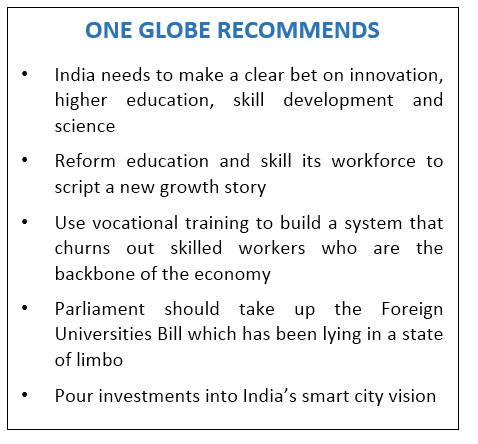The key drivers of a knowledge society
Posted by Admin on December 06, 2017
 |
India needs to make a clear bet on innovation, education, skill development, research, and science, the key drivers of a knowledge society, said Dalbir Singh, Senior Advisor for the Forum of Federations, Canada, in his welcome address at the 2017 One Globe Forum. People from 25 countries attended the two-day global summit in Delhi. “One Globe was conceived to promote intellectual capital, and stir debate on what it takes to build a sustainable 21st century knowledge economy in India and South Asia,” said Mr Singh. He said the summit would drill deep into the linkages between growth and higher education, entrepreneurship, job creation, investments, public health and smart cities. “We have to develop a multidimensional perspective to weave together the invisible threads that go into building a knowledge society.”
He said in the next 5 years India would have the largest youth population: 465 million in the age group 20 to 35. “We have always marveled at the idea of India’s demographic dividend, but we can only sustain this advantage if we train our workforce adequately and equip young people with new skills. Currently, there are huge gaps.”
He noted that 15% of India’s workforce was formally skilled, as against 47% in China, 96% in South Korea, 80% in Japan, 75% in Germany and 68% in the UK. He said India currently over-produces students with tertiary education and under-produces people with vocational skills. Sarva Shiksha Abhiyan, the government’s flagship education program, has brought 95% of children to school but dropout rates are high, and the quality of education is poor. The scheme was a step towards bridging the rural-urban gap, he said, but added: “We cannot lose sight of the glaring infrastructure deficiencies; 45% of schools don’t have toilets, 24% no drinking water, and almost 70% no computers.”
He said India needed to boost higher education and bring the Foreign Universities Bill out of limbo. Foreign universities have been waiting for almost a decade for the Indian parliament to open up the heavily regulated education sector.
He ended his speech on an optimistic note, saying the government was addressing challenges through missions such as Skill India, Digital India, Make in India, Startup India, Smart Cities and liberalization of defense manufacturing. Their success would determine the fortunes of India’s demographic dividend, he said.
After a formal, traditional lamp-lighting ceremony, One Globe Forum convener Mr Harjiv Singh welcomed the gathering and introduced the dignitaries on the stage: Mr Rao Inderjit Singh, Minister of State for Housing & Urban Poverty Alleviation, Government of India, Lord Raj Loomba, Member of the House of Lords and Chairman of The Loomba Foundation, which champions widows’ rights, Indian American entrepreneur Mr Shalabh Kumar, Founder of the Republican Hindu Coalition and of the AVG Group, and Dr Mukesh Aghi, President of the US-India Business Council.
Mr Singh highlighted the dignitaries’ roles in relation to the overarching themes of the One Globe Forum, and noted that the three major challenges of building a 21st century knowledge economy in South Asia were employment, education, and public health. “As my favorite poet, Robert Frost, said, we have miles to go before we sleep,” he said.
In his speech, Dr Aghi noted that the new US administration presented an opportunity for India to expand its role in global trade and geopolitics. Keynote speaker Mr Shalabh Kumar concurred, and highlighted the shared interests of the US and India, especially expansion of bilateral trade and curbing terrorism. “The day Congress passes the law to remove artificial barriers to increase trade between the US and India, President Trump will sign it. So you can expect trade to increase in a significant way,” he said. He said that he expected US-India trade to touch $300 billion in 4 years and that immigration concerns would not affect India unduly.
In his inaugural address, Honorable Minister Mr Rao Inderjit Singh expressed appreciation that other speakers had addressed migration issues. He noted centuries of migrants had helped develop India into the diverse country that it is today. Through it all, he noted, India’s villages had sustained themselves. Quoting Oliver Goldsmith, he said, “Princes and lords may flourish, or may fade. A breath can make them, as a breath has made. But a bold peasantry, their country’s pride, when once destroyed can never be supplied.” Today, this rural population is moving to cities. “From 90% of the population living in villages before, to 31% in urban areas now, is a lot of pressure on our cities,” he said. “By 2050, 70% of the world’s population will be in urban centers. That’s a mindboggling figure, more so for India. So our cities must become livable if India is to prosper.” This was the reason for India’s smart cities mission, he said.
Delivering the vote of thanks, Baron Loomba expressed his gratitude to the distinguished guests on the dais. Following up on Mr Rao Inderjit Singh’s observations about India’s villages, he underscored the importance of empowering women. “It is important to develop urban centers, but while we build 100 smart cities, we should also make villages functional,” he said.








